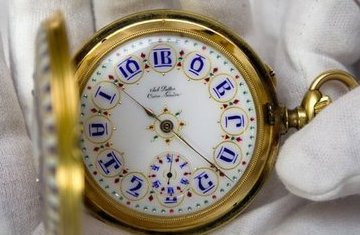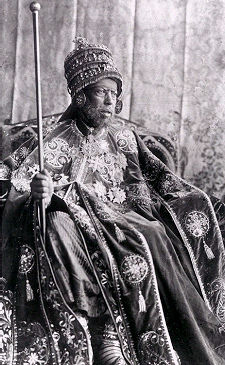 A pocket watch made for Ethiopian Emperor Menelik II, dating back to 1893, was recently sold at an auction in Geneva.
A pocket watch made for Ethiopian Emperor Menelik II, dating back to 1893, was recently sold at an auction in Geneva.
Tadias Magazine
By Tadias Staff
Published: Monday, November 23, 2009
New York (TADIAS) – An exquisite pocket watch, made for Emperor Menelik II of Ethiopia, dating back to 1893, was recently sold at Sotheby’s auction block in Geneva at price of 52,500 Swiss Franc, the equivalent of 51,595.95 U.S. dollars.
According to a catalogue issued by Sotheby’s, the historical watch, featuring white enamel dial with Ethiopian numerals as the hour indicator, “was a gift to Léon Chefneux in recognition of his contribution to the implementation of Ethiopia’s first railway line, as inscribed on the inside of the case ‘Don de Sa Majesté Menelik II Empereur d’Ethiopie’.”
This pocket watch, however, is also a symbol of the larger-than-life personality of one of the most celebrated monarchs in Ethiopia’s modern history. Emperor Menelik’s first claim to international reputation occurred in 1896 when his army scored a decisive victory against invading Italian forces, marking the first time that an African country had defeated a European colonial power.
As the Ethiopian historian Bahru Zewde noted, “Few events in the modern period have brought Ethiopia to the attention of the world as has the victory at Adwa.” News reports describing Italian soldiers fleeing in panic sent shockwaves throughout Europe. In Italy, riots broke out and the government of Prime Minister Francesco Crispi was forced to resign. Italy eventually signed the Treaty of Addis Ababa – recognizing the independence of Ethiopia.
Elsewhere in the world, shouts of “Viva Menelik” would emerge as a battle cry for anti-colonial movements. For those who still lived under the yoke of racial discrimination, Ethiopia’s victory “would become a cause célèbre,” writes Scholar Fikru Negash Gebrekidan, “a metaphor for racial pride and anti-colonial defiance.” Soon, inspired by the Emperor, African Americans and Blacks from the Caribbean Islands began to make their way to Ethiopia. In 1903, accompanied by Haitian poet and traveler Benito Sylvain, an affluent African American business magnate by the name of William Henry Ellis arrived in Ethiopia to greet and make acquaintances with Menelik. A prominent physician from the West Indies, Dr. Joseph Vitalien, also journeyed to Ethiopia and eventually became the Emperor’s trusted personal physician.
King Menelik’s era is also characterized by his attempts to modernize his empire. Menelik introduced the country’s first telephone and telegraph lines and presided over the inaugurations of the nation’s first bank and post office.
The Emperor’s colorful personality has been described by generations of writers, but none more vividly than the one offered by 37-year-old American diplomat named Robert P. Skinner. In 1906, Mr. Skinner, who had been appointed by President Theodore Roosevelt to negotiate a commercial treaty with the African kingdom, published a memoir detailing his encounter with the charismatic head of state.
“The emperor was amazed when I handed him a project of treaty written in his own language by Professor Littmann, of Princeton University,” writes Mr. Skinner. “He said that it was remarkable that a man who had had only the opportunities for study afforded by books should have such a command of the language as Professor Littmann.”
Skinner goes on to describe Menelik’s intellectual curiosity and his affinity for technological advances. He highlights that the Emperor kept abreast of international affairs via Reuter news service, which used the telegraph line to provide news. The Emperor also received weekly dispatches through the Ethiopian postal service, which were then translated into Amharic for his review.
“He knew of our war with Spain, he knew something of our war with Great Britain, and he had a realization, though vague, of our might and power,” says Ambassador Skinner. “His thirst for information is phenomenal.” When Skinner presented Menelik with a signed copy of President Roosevelt’s photo, he carefully studied the image with an expression of familiarity with the subject. The American writes: “He had heard, evidently, a good deal about the President, whose personality interested him much. He knew him to be sportsman, and hoped that he would one day visit Ethiopia. He wanted to know his age, and how he had come to be President.”
Skinner described the Emperor’s sense of humor and adventurous spirit as in a scene during a gift exchange at the palace luncheon hosted by Menelik in honor of the American delegation. No sooner had the visitors finished demonstrating the latest model American rifle, the Emperor grabbed the gun and proceeded to aim it at the dining room doorway without leaving his seat, causing the invited Ethiopian dignitaries to run for cover. “There was immediately a wild stampede for cover on the part of the satellites while the imperial hand pulled the trigger,” muses Skinner. “The Emperor’s eyes showed that he appreciated the humor of the situation.” And Menelik later intimates his love of joking to Skinner: “I am going to my country place in Addis Alem next week,” he said, “and I shall be accompanied by many officers. I expect to amuse myself with these cartridges. I shall be able to teach some of my officers to show courage under fire.”
However, the tone was decidedly serious when the Americans unveiled a ‘writing-machine.’ “The practical mind of the Emperor developed the question immediately,” writes Ambassador Skinner. “Why can’t we have an Amharic typewriter?” Skinner quotes a French gentleman, Mr. Léon Chefneux, who was present at the occasion as having replied to the Emperor as follows: “whereas we had only 26 letters in our alphabet, it would require 251 characters for the Amharic language, and the construction of a machine containing so many figures presented practical difficulties.”
Mr. Chefneux was the gentleman whose family until recently had owned Emperor Menelik’s pocket watch that was auctioned in Geneva.
—-
Related:
Picture of the Week: Emperor Menelik’s Pocket Watch
Join the conversation on Twitter and Facebook.



























Its great that there is an article to tell of the emperor and his personality and of how things were at the time of the defeat of the Italians. Sadly in this day and age many don’t know of Ethiopian kings and of there rich history. I find it interesting that after Menelik crushed the Italians that all the so-called world powers wanted to become friends. Its a shame that respect for Ethiopia or for that matter other African kingdoms had to come after bloodshed. I personally didn’t know that blacks from the Caribbean or America ventured to Abyssinia afterwards. I find that interesting because I am a majoring in African studies. Thank you Tadias for providing information that most here in the west do not value. Being of African descent I am proud that our history is now being recognized.
Thank you for this fascinating piece of information! Wow!
Shouldn’t this pocket watch be placed in a museum in Ethiopia? It is disappointing that the National Museum of Ethiopia did not participate in the auction in order to acquire and bring the historic pocket watch home, where it belongs.
Very good story on Menelik II. I have two suggestions for the two writers.
Antonio – if you want to know more about Ethiopian Aristocrats, you definitely need to go to Ethiopia and do some research. Do not just go to Addis Abeba. That would be a waste of time and money. You would be amazed, albet questionable, on how much oral history is told by the elders in rural/village Ethiopia. Some times it would be hard to verify or to quote a reliable source, nevertheless it is worth it.
Bezawit – one – no one knows who won this auction. There are plenty speculative rumors as to who bid and who went home with it at the end. Two – The Museum you mention would not have the money and the know how to bid and outbid. I am actively involved in auctions and can tell you there were steps to be taken if the Museum had wanted this item. I would not be surprised a bit if I come to know that the Museum did not even know about this auction after all! I recently purchased an original sheet of stamps with different pictures of Menelik (1893), Taitu (1903)and Selassie (1921). The stamps are beleived to be one of the first that bear the features of Menelik and Taitu.
Thanks for the advice. i actually plan to travel to ethiopia next winter. My girlfriend is from addis and i would love to check out the historical sites in ethiopia.
Thank you for this piece of information about the humorous Ethiopian King Menelik. I found the story fascinating. I would like to receive a copy of the re-issue of Ambassador Robert P. Skinner’s memoir.
Best Regards
Now that was interesting! We need more journals like Robert P. Skinner’s. I can imagine how interesting it could have been talking to King Menelik!
I want to wright a play about Menelik and any useful info please share it with me!
this is my e-mail sasibilove@yahoo.com
thanks
Wow, that was indeed a great story.
Its unfortunate that Empreror Menelik is talked about more negatively by different ethnic groups in Ethiopia that one never seems to hear the positive stuff except in headlines.
Thank you for the enlightenment.
A very interesting read indeed
tadias, why did you cancele a very important information that gave you about the wach. we told you the wach was given to king menelik. king Menelike didnt give it to any one it was in the royal family house here in virginia the servant stolt it because he was not paid his salary. There is a police record and we know it was in his hands. There is a lot to tell about this man. This matter should be investgated by the Ethiopian Gov. and the wach should be returned.
The wach was stolen from America from the Royal family house ok! the servant sold it to one rich Areb for only $10,000 dollar because he was desperate to leave USA we know first hand please dont egnor this.